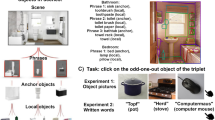Abstract
Information describing the layout of objects in space is commonly conveyed through the use of linguistic terms denoting spatial relations that hold between the objects. Though progress has been made in the understanding and modelling of many individual relations, a better understanding of how human subjects use spatial relations together in natural language to is required. This paper outlines the design and completion of an experiment resulting in the collection of 1920 spoken descriptions from 32 human subjects; they describe the relative positions of a variety of objects within an image space. We investigate the spatial relations that the subjects express in their descriptions, and the terms through which they do so, in an effort to determine variations and commonalities. Analysis of the descriptions determines that common elements of spatial perception do indeed exist between subjects, and that the subjects are quite consistent with each other in the use of spatial relations.
Access this chapter
Tax calculation will be finalised at checkout
Purchases are for personal use only
Preview
Unable to display preview. Download preview PDF.
Similar content being viewed by others
References
Freeman, J. (1975) “The Modeling of Spatial Relations”, Computer Graphics and Image Processing, (4),156-171.
Gapp, K. P. (1995) “Angle, Distance, Shape, and their Relationship to Projective Relations”, Proceedings of the17th Annual Conference of the Cognitive Science Society, San Diego, CA, 112-117.
Hall, E. T. (1966) The Hidden Dimension, New York: Doubleday.
Halpern, D. F. (1986) Sex Differences in Cognitive Abilities, Hillsdale, NJ: Lawrence Erlbaum Associates Press.
Herskovits, A. (1986) Language and Spatial Cognition: A Interdisciplinary Study of the Prepositions in English. Cambridge, England: Cambridge University Press.
Landau, B. (1996) “Multiple Geometric Representations of Objects in Language and Language Learners”, in P. Bloom, M. Peterson, L. Nadel, and M. Garrett (eds), Language and Space, Cambridge: MIT Press, 317-363.
Linn, M. C. and Petersen, A. C (1985) “Emergence and Characterization of Gender Differences in Spatial Ability: A Meta-Analysis”, Child Development, 56(6), 1479-1498.
Mark, D. M., Comas, D., Egenhofer, M. J., Freundschuh, S. M., Gould, M. D. and Nunes, J (1995) “Evaluating and Refining Computational Models of Spatial Relations Through Cross-Linguistic Human-Subjects Testing”, in Frank, A. U. and Kuhn, W. (eds), Spatial Information Theory: A Theoretical Basis for GIS, number 998, Springer-Verlag, Lecture Notes in Computer Sciences: Berlin, 553-568.
Mark, D. M. and Egenhofer, M. J. (1994) “Modeling Spatial Relations Between Lines and Regions: Combining Formal Mathematical Models and Human Subjects Testing”, Cartography and Geographic Information Systems, 21(4),195-212.
Montello, D. R. (1995) “How Significant Are Cultural Differences in Spatial Cognition?”, in Frank, A. U. and Kuhn, W. (eds), Spatial Information Theory: A Theoretical Basis for GIS, Springer-Verlag, Lecture Notes in Computer Sciences: Berlin, 485-500.
Regier, T. P. (1992) The Acquisition of Lexical Semantics for Spatial Terms: A Connectionist Model of Perceptual Categorization”, PhD thesis, University of California at Berkeley, USA.
Robinson, V. B. (1990) “Interactive Machine Acquisition of a Fuzzy Spatial Relation”, Computers and Geosciences, 16(6), 857-872.
Talmy, L. (1983) “How Language Structures Space”, in Pick, H. and Acredolo, L. (eds), Spatial Orientation: Theory, Research, and Application,New York: Plenum Press, 225-282.
Wang, X. and Keller, J. M. (1999) “Fuzzy Surroundedness”, Fuzzy Sets and Systems, 101(1), 5-20.
Wang, X. and Keller, J. M. (1997) “Human-based Spatial Relationship Generalization through Neural Fuzzy Approaches”, Proceedings of the Sixth IEEE International Congress on Fuzzy Systems, Barcelona, Spain, 1173-1178.
Whorf, B. L. (1940) “Science and Linguistics”, Technological Review, 42(6), 229-231, 247-248.
Worboys, M. F. (2001) “Nearness Relations in Environmental Space”, International Journal of Geographical Information Science, 15(7), 633-651.
Zhan, F. B (2002) “A Fuzzy Set Model of Approximate Linguistic Terms in Descriptions of Binary Topological Relations Between Simple Regions”, in Matsakis, P. and Sztandera, L.M. (eds), Applying soft computing in defining spatial relations, Physica-Verlag, Heidelberg, Germany, 179-202.
Author information
Authors and Affiliations
Editor information
Editors and Affiliations
Rights and permissions
Copyright information
© 2008 Springer-Verlag Berlin Heidelberg
About this paper
Cite this paper
Wang, X., Matsakis, P., Trick, L., Nonnecke, B., Veltman, M. (2008). A Study on how Humans Describe Relative Positions of Image Objects. In: Ruas, A., Gold, C. (eds) Headway in Spatial Data Handling. Lecture Notes in Geoinformation and Cartography. Springer, Berlin, Heidelberg. https://doi.org/10.1007/978-3-540-68566-1_1
Download citation
DOI: https://doi.org/10.1007/978-3-540-68566-1_1
Publisher Name: Springer, Berlin, Heidelberg
Print ISBN: 978-3-540-68565-4
Online ISBN: 978-3-540-68566-1
eBook Packages: Earth and Environmental ScienceEarth and Environmental Science (R0)




